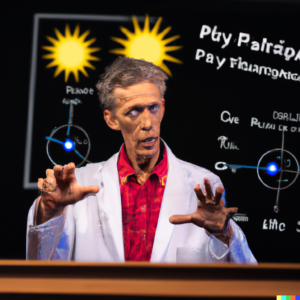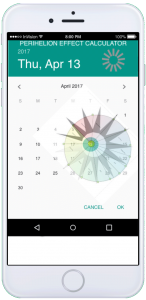The closeness of the orbit of the earth to the sun, it’s velocity and the intensity of the solar fields all coincide with the Winter Holidays in December. This change in bio-psychic energy seems to alter the perception of time. Many stories, books, movies and anecdotes support the validity of this feeling, Perhaps this is due to the distortion of space-time, or perhaps it is a biological response to the acceleration/deceleration of the slingshot orbit of earth at this time. The essay below lends some credence to the subject distortion of time theory
Hancock, Peter & Szalma, James & L Weaver, J. (2018).
Increased understanding of the mechanisms by which stress impacts performance is essential to the design and operation of complex information systems on the modern battlefield. This paper will briefly examine the theoretical explanations for attentional narrowing, and frame this effect within a wider investigation of stress effects on human performance. Narrowing is considered here to be a central phenomenon that applies to temporal as well as to spatial perception.
ABSTRACT
Increased understanding of the mechanisms by which stress impacts performance is essential to the design and operation of complex information systems on the modern battlefield. This paper will briefly examine the theoretical explanations for attentional narrowing, and frame this effect within a wider investigation of stress effects on human performance. Narrowing is considered here to be a central phenomenon that applies to temporal as well as to spatial perception.
1. INTRODUCTION
The modern electronic battlefield requires soldiers to process complex information from multiple sources. The substantial information load technological advances place upon individuals in combat environments can induce considerable stress and impair performance. It is therefore critical to develop methods to minimize these negative effects. Such an effort requires development of a sound theoretical model of stress and performance. This paper aims to further the development of such a model by examining the perceptual distortions that occur under stress.
2. DISTORTIONS OF PERCEPTUAL SPACE
One way in which stress impacts performance is through perceptual distortions resulting from a ‘narrowing’ of the range of cues individuals extract from the surrounding environment. The impetus for research in this area was provided by Easterbrook (1959), who asserted that emotional arousal restricts the utilization of the range of cues from the sensory environment. Easterbrook’s proposal is spatial in conception implying that, under conditions of chronic or acute stress, peripheral stimuli are sacrificed at the expense of more centrally located cues. As attention narrows (i.e. as the number of cues attended to is reduced), performance capacity is preserved by the retention of focus on salient cues. Eventually, performance fails as stress increases and even salient cues become excluded. Given that extremes of under-load are as stressful as extremes of overload, it is evident that this proposition supports an inverted-U (Yerkes & Dodson, 1908), or an extended-U (Hancock & Warm, 1989) shaped function describing the relationship between stress level and performance efficiency. However, early investigations aimed at testing
Easterbrook’s model of attentional narrowing under stress confounded sensory and attentional effects, largely because of an emphasis on the visual modality. More recent evidence indicates that ‘narrowing’ is an attentional effect and that cue salience can dictate the locus in the sensory field toward which such limited attentional resources are focused (see Dirkin & Hancock, 1984). Narrowing extends beyond the visual sensory domain, and in this paper we are particularly concerned with distortion in time perception and its relation to narrowing on the spatial dimension.
3. DISTORTIONS OF TIME PERCEPTION
Phenomenologically, individuals who experience ‘time distortion’ under stress report one of two forms of experience, in which time either appears to speed up or slow down (see Fair, 1984). Each of these patterns represent effects of ‘time-in-memory’ that are evident in the memory for the event. In these retrospective accounts, individuals are recalling events rather than referring to their experience in passing. In stress conditions sufficient to induce the first kind of time distortion, the increase in event registration must be substantial. For such an individual, recalling the incident in memory is characterized by recognition of the time distortion itself and clarity of recall of many events which, since they cannot be reconciled with common time experience, are reported as being outside the normal run of behavior, e.g., “time seemed to slow down.”
In contrast, when attention is not directed toward the environment but instead re-directed toward ‘internal’ events, few if any events are registered. Without sufficient events to fill an epoch, time seems suddenly ‘speeded’. Thus, the phenomenological appearance of time co-varies with the rate of event registration. To the individual recalling such an incident time would appear to have speeded up and everything would have gone past ‘in a blur’. The next step is to understand how stress produces these reactions, and for this we have to link stress reaction to attentional strategy.
4. SPATIO-TEMPORAL DISTORTIONS
Hancock and Weaver (2002) proposed that the narrowing that occurs on the spatial dimension also occurs in perception of time, and that these distortions have a common mechanism. Restricted attentional capacity, which results from stress, induces change in the strategic manner in which remaining resources are directed. Specifically, there is a reduction in environ- mental sampling, which results in a phenomenological distortion of perceived space-time. This adaptive response to dwindling resources remains effective in sustaining performance level only so long as such attention is directed to critical task-related cues. As new information is introduced into or is relocated in the environment, the adverse effects of resource limitations manifest themselves in reduced response efficiency. These effects are exacerbated by increasing the duration and/or the intensity of the stress.



